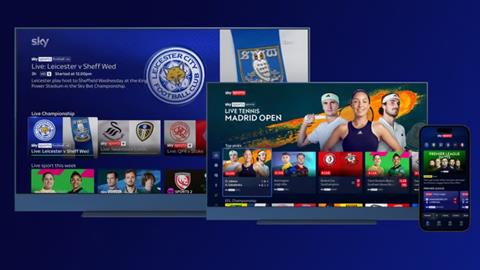Sky is in the midst of a multifaceted digital transformation aimed at redefining both operations and the customer experience. IBC365 spoke with Cristina Gomila to find out more.
Prior to joining Sky, Cristina Gomila performed several roles at Technicolor, ultimately becoming their CTO. She was deeply involved in areas such as film production, post-production, and VFX, gaining experience that now informs her current role as Managing Director of Content Technology and Innovation. Five years ago, Sky approached Gomila with an ambitious vision. “Sky explained to me the massive challenge of transforming a classical broadcast distribution environment into a modern media company,” she recalls. “That was an amazing challenge – I could not say no.”

Gomila took on the task of driving a large-scale technological overhaul. This shift also required transforming teams and workflows across the organisation. “We fully embraced Cloud, data, and AI, and started a massive transformation of the teams and the way of working,” she says. Today, Cristina’s role not only encompasses overseeing this digital transformation, but also ensuring that these technologies enhance customer experience, operational resilience, and sustainability.
The transformation of a broadcasting giant like Sky is no simple feat, and Gomila believes in taking a long-term approach to such a shift. “Every year, there’s something new happening in this industry that challenges us further,” she says. “At the same time, five years is short, but long enough to start proving its value.”
Sky began its transition to IP by implementing a 2022-6 network. “It came with some challenges,” she says. “Especially when we went to UHD and very big formats.” So, the decision was made to move to SMPTE 2110. “We are currently in the process of overhauling our entire routing infrastructure,” she adds. “It’s a challenging process. You have to have a well-crafted plan, because the investment is big. We have adopted a phased approach, where we started with replacing the contribution signal processing. Moving forward, our ambition would be one day to have all the production control rooms as IP-based.”
Benefits and challenges of IP migration
For Sky, IP migration has brought several benefits, particularly in terms of scalability, flexibility, and support for remote production. “IP offers broadening capacity, especially valuable as sports fit and volumes grow,” Gomila notes. With IP, Sky can manage the surge in resource demands that come with major live events, such as sports broadcasts, more efficiently than ever before. This scalability has allowed Sky to introduce new content and interactive features that were previously constrained by SDI’s physical limitations.

Remote production is another significant advantage of IP. By leveraging IP, Sky’s teams can produce, edit, and manage content from multiple locations, creating a decentralised production model that is highly adaptable. This capability has been crucial for Sky’s sports broadcasting, where remote production enables a seamless experience despite logistical challenges. “The way IP allows for content to be produced, edited, and managed from multiple locations is a huge advantage,” Gomila adds.
However, the transition to IP has come with its own set of challenges. Upskilling and training were essential to bridge the knowledge gap between SDI and IP technologies. “These are very different skills from SDI to IP,” she explains, highlighting the importance of equipping Sky’s engineers with the necessary tools and training. Careful planning was needed to avoid disrupting ongoing operations. “Don’t go for a full blast, otherwise there could be risk of downtime, because you are doing a very critical migration with real-time on-prem equipment,” she says.
Software-based orchestration has been a key enabler of Sky’s Cloud transformation, allowing for continuous integration, security, and disaster recovery within a virtual environment. By redesigning workflows to align with Cloud infrastructure, Sky has achieved greater agility and resilience, transforming traditional production models to fully leverage Cloud’s potential. Cristina highlights the importance of orchestrating Cloud-based systems with a software-first approach, explaining, “We have CICD deployment pipelines and active-active disaster recovery, meaning I don’t need to keep cold rooms ready to power up.”
Sky’s hybrid approach
The adoption of Cloud technologies has been a cornerstone of Sky’s transformation. “Over the last five years, but I would say probably accelerated on the last three of them, we have made significant progress in embracing Cloud,” says Gomila. “We have Cloud over the entire content supply chain. We use it in storage and archive, live production, channel play-out, platform distribution, and delivery.” Sky has adopted a “Cloud-first” mentality but recognises the need for a hybrid approach. Gomila explains, “As you embrace Cloud, you have to be flexible. Hybrid is probably going to be the best solution. Embracing Cloud doesn’t mean everything has to be on Cloud. You have to migrate to Cloud what makes sense - because of the volumes, the challenges, the investment. Having said that, we have a ‘Cloud-source mentality,’ if it works on Cloud, we migrate to Cloud,” she says.
Sky’s hybrid Cloud model enables the flexibility to handle varying levels of demand, especially during high-profile events like major sports broadcasts, where a rapid increase in resources is often necessary. By combining public and private Cloud resources, Sky can achieve optimal cost-efficiency while retaining the scalability needed for large-scale live events.
Impacts across the organisation
Migrating to the Cloud has also necessitated a shift from a capital expenditure (capex) model, where investment is made in physical infrastructure, to an operational expenditure (opex) model, where resources are paid for as needed. This shift requires rethinking budgeting and resource allocation strategies across the organisation. “Broadcast has always viewed investments in hardware, but with Cloud, it becomes a recurring operational cost,” Gomila notes, acknowledging that this change requires a partnership between Sky’s financial, technical, and business teams.
Gomila highlights the importance of financial operations (FinOps) in managing Cloud costs effectively, noting that a strong financial framework is crucial to maintaining cost efficiency in a Cloud-based environment. “It’s essential to build a solid deployment on FinOps,” she explains. This collaborative approach ensures that Sky’s Cloud strategy aligns with broader organisational goals, creating a shared sense of responsibility among different teams for optimising resource usage.
She stresses the importance of communication and education throughout the organisation. “One of the massive challenges is to onboard your company in the understanding of the change,” she says. “I think that it has to be a partnership between business functions, financial teams, and technical teams to understand what the changes bring, what the challenges are, and the advantages. This is not just about migrating what you have on-prem to Cloud - that will probably be very expensive and inefficient. You have to rethink the workflows, you have to design, and you have to give yourself continuous cost targets.”
Future of production and personalised experiences
At the heart of Sky’s strategy is the ambition to create a seamless and engaging experience for customers, and she sees IP and Cloud technologies as the foundation for a new era of media production. With Cloud-based infrastructure, production workflows can be more automated and efficient, allowing Sky to deliver content faster and with greater functionality.

Gomila feels that the scale and flexibility enabled by IP and Cloud are particularly suitable to sport, which is very spiky in its demand for resources. “I always consider it an enabler to everything else that we want to do,” she says. “Being on Cloud opens the door to a lot of real-time analysis and connecting data.” Sky’s Sports Plus feature, which offers viewers the option to select from multiple camera angles, is one example of how Cloud and IP can create more interactive and personalized viewing experiences.
She envisions a future where more content, such as youth and amateur sports, can be streamed to viewers, leveraging Cloud-driven automation to reduce costs and improve accessibility. “Our goal is to offer more content, better experiences, and make it affordable,” she says.
Sustainability and Cloud providers
Sky’s move to IP and Cloud technologies is also aligned with its commitment to sustainability. Cloud adoption, Gomila notes, offers substantial environmental benefits, as Cloud-hosted data centres are generally more energy-efficient than traditional on-premise servers. “Cloud brings a major advantage when you really do the calculations for energy consumption and how efficient the Cloud providers are compared to doing it yourself,” she says.
Sky’s sustainability efforts extend to its partnerships, with the company encouraging vendors to adopt environmentally friendly practices. Gomila continues: “Sky is very strict about sustainability standards - not only with Cloud providers but with all our partners.” Remote production capabilities enabled by IP further reduce travel requirements, minimising Sky’s carbon footprint and supporting its sustainability objectives.
Sky’s adoption of IP and Cloud technologies represents more than just a technical upgrade - it’s a transformation that reshapes how media is produced, distributed, and consumed. Under Gomila’s leadership, this journey is about using technology to enhance customer experience, foster sustainable practices, and create a resilient, forward-looking organisation. “The technology is here to serve the customer. We want to provide more, make it affordable, and deliver better experiences, “she says.
























No comments yet